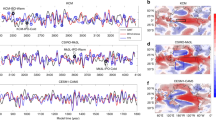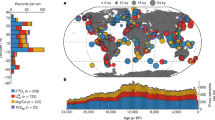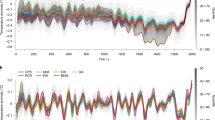Abstract
Incomplete understanding of three aspects of the climate system—equilibrium climate sensitivity, rate of ocean heat uptake and historical aerosol forcing—and the physical processes underlying them lead to uncertainties in our assessment of the global-mean temperature evolution in the twenty-first century1,2. Explorations of these uncertainties have so far relied on scaling approaches3,4, large ensembles of simplified climate models1,2, or small ensembles of complex coupled atmosphere–ocean general circulation models5,6 which under-represent uncertainties in key climate system properties derived from independent sources7,8,9. Here we present results from a multi-thousand-member perturbed-physics ensemble of transient coupled atmosphere–ocean general circulation model simulations. We find that model versions that reproduce observed surface temperature changes over the past 50 years show global-mean temperature increases of 1.4–3 K by 2050, relative to 1961–1990, under a mid-range forcing scenario. This range of warming is broadly consistent with the expert assessment provided by the Intergovernmental Panel on Climate Change Fourth Assessment Report10, but extends towards larger warming than observed in ensembles-of-opportunity5 typically used for climate impact assessments. From our simulations, we conclude that warming by the middle of the twenty-first century that is stronger than earlier estimates is consistent with recent observed temperature changes and a mid-range ‘no mitigation’ scenario for greenhouse-gas emissions.
This is a preview of subscription content, access via your institution
Access options
Subscribe to this journal
Receive 12 print issues and online access
$259.00 per year
only $21.58 per issue
Buy this article
- Purchase on Springer Link
- Instant access to full article PDF
Prices may be subject to local taxes which are calculated during checkout



Similar content being viewed by others
References
Forest, C. E., Stone, P. H., Sokolov, A. P., Allen, M. R. & Webster, M. D. Quantifying uncertainties in climate system properties with the use of recent climate observations. Science 295, 113–116 (2002).
Knutti, R., Stocker, T. F., Fortunat, J. & Plattner, G. K. Constraints on radiative forcing and future climate change from observations and climate model ensembles. Nature 416, 719–723 (2002).
Stott, P. A. et al. Observational constraints on past attributable warming and predictions of future global warming. J. Clim. 19, 3055–3069 (2006).
Harris, G. R. et al. Frequency distributions of transient regional climate change from perturbed-physics ensembles of general circulation model simulations. Clim. Dynam. 27, 357–375 (2006).
Meehl, G. A. et al. The WCRP CMIP3 multimodel dataset: A new era in climate change research. Bull. Am. Meteorol. Soc. 88, 1383–1394 (2007).
Collins, M. et al. Climate model errors, feedbacks and forcings: A comparison of perturbed-physics and multi-model ensembles. Clim. Dynam. 36, 1737–1766 (2010).
Kiehl, J. Twentieth century climate model response and climate sensitivity. Geophys. Res. Lett. 34, L22710 (2007).
Knutti, R. Why are climate models reproducing the observed global surface warming so well? Geophys. Res. Lett. 35, L18704 (2008).
Huybers, P. Compensation between model feedbacks and curtailment of climate sensitivity. J. Clim. 23, 3009–3018 (2010).
Knutti, R. et al. A review of uncertainties in global temperature projections over the twenty-first century. J. Clim. 21, 2651–2663 (2008).
Forest, C. E., Stone, P. H. & Sokolov, A. P. Constraining climate model parameters from observed 20th century changes. Tellus A 60, 911–920 (2008).
Boé, J., Hall, A. & Qu, X. Deep ocean heat uptake as a major source of spread in transient climate change simulations. Geophys. Res. Lett. 36, L22701 (2009).
Friedlingstein, P. et al. Climate-carbon cycle feedback analysis: Results from the C4MIP model intercomparison. J. Clim. 19, 3337–3353 (2006).
Milly, P. C. D., Dunne, K. A. & Vecchia, V. Global pattern of trends in stream flow and water availability in a changing climate. Nature 428, 347–350 (2005).
Tebaldi, C. & Sansó, B. Joint projections of temperature and precipitation change from multiple climate models: A hierarchical Bayesian approach. J. R. Stat. Soc. A 172, 83–106 (2009).
Murphy, J. M. et al. Quantification of modelling uncertainties in a large ensemble of climate change simulations. Nature 430, 768–772 (2004).
Jackson, C. S., Sen, M. K., Huerta, G., Deng, Y. & Bowman, K. P. Error reduction and convergence in climate prediction. J. Clim. 21, 6698–6709 (2008).
Nakicenovic, N. & Swart, R. Special Report on Emissions Scenarios (Cambridge Univ. Press, 2000).
Brohan, P., Kennedy, J. J., Harris, I., Tett, S. F. B. & Jones, P. D. Uncertainty estimates in regional and global observed temperature changes: A new data set from 1950. J. Geophys. Res. 111, D12106 (2006).
Knutti, R., Furrer, R., Tebaldi, C., Cermak, J. & Meehl, G. A. Challenges in combining projections from multiple climate models. J. Clim. 23, 2739–2758 (2010).
Weigel, A. P., Knutti, R., Liniger, M. & Appenzeller, C. Risks of model weighting in multimodel climate projections. J. Clim. 23, 4175–4191 (2010).
Frame, D. J. et al. Constraining climate forecasts: The role of prior assumptions. Geophys. Res. Lett. 32, L09702 (2005).
Easterling, D. R. & Wehner, M. F. Is the climate warming or cooling? Geophys. Res. Lett. 36, L08706 (2009).
Solomon, S. et al. Contributions of stratospheric water vapor to decadal changes in the rate of global warming. Science 327, 1219–1223 (2010).
Lockwood, M. Solar change and climate: An update in the light of the current exceptional solar minimum. Phil. Trans. R. Soc. Lond. A 466, 303–329 (2010).
Stone, D. A. & Allen, M. R. Attribution of global surface warming without dynamical models. Geophys. Res. Lett. 32, L18711 (2005).
Betts, R. A. et al. When could global warming reach 4 °C. Phil. Trans. R. Soc. Lond. A 369, 67–84 (2011).
Desaii, S., Hulme, M., Lempert, R. & Pielke, R. Jr Do we need better predictions to adapt to a changing climate? Eos 90, 111–112 (2009).
Hall, A. & Qu, X. Using the current seasonal cycle to constrain snow albedo feedback in future climate change. Geophys. Res. Lett. 33, L03502 (2006).
Frame, D. J. et al. The climateprediction.net BBC climate change experiment: Design of the coupled model ensemble. Phil. Trans. R. Soc. Lond. A 367, 855–870 (2009).
Acknowledgements
We thank all participants in the climateprediction.net experiments, as well as the academic institutions and the individuals who have helped make the experiment possible, particularly D. Anderson for developing the Berkeley Open Infrastructure for Network Computing. We also thank the Natural Environment Research Council (NERC), the European Union FP6 WATCH and ENSEMBLES projects, the Oxford Martin School, the Smith School of Enterprise and the Environment and Microsoft Research for support and J. Renouf and co-workers at the BBC for their documentaries explaining and promoting this experiment. D.J.R. was supported by a NERC PhD studentship with a CASE award from the Centre for Ecology & Hydrology (CEH) Wallingford.
Author information
Authors and Affiliations
Contributions
All authors contributed to the design and implementation of the experiment. D.J.R. performed the analysis and wrote the paper, with significant contributions from D.J.F., M.R.A. and N.M. All authors commented on the paper.
Corresponding author
Ethics declarations
Competing interests
The authors declare no competing financial interests.
Supplementary information
Supplementary Information
Supplementary Information (PDF 1862 kb)
Rights and permissions
About this article
Cite this article
Rowlands, D., Frame, D., Ackerley, D. et al. Broad range of 2050 warming from an observationally constrained large climate model ensemble. Nature Geosci 5, 256–260 (2012). https://doi.org/10.1038/ngeo1430
Received:
Accepted:
Published:
Issue Date:
DOI: https://doi.org/10.1038/ngeo1430
This article is cited by
-
Biochemical and molecular effects of naringenin on the cardiovascular oxidative and pro-inflammatory effects of oral exposure to diesel exhaust particles in rats
Air Quality, Atmosphere & Health (2021)
-
A perturbed parameter ensemble of HadGEM3-GC3.05 coupled model projections: part 2: global performance and future changes
Climate Dynamics (2021)
-
Finding plausible and diverse variants of a climate model. Part 1: establishing the relationship between errors at weather and climate time scales
Climate Dynamics (2019)
-
Finding plausible and diverse variants of a climate model. Part II: development and validation of methodology
Climate Dynamics (2019)
-
Land managers’ behaviours modulate pathways to visions of future land systems
Regional Environmental Change (2018)



